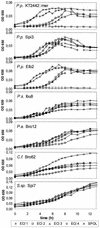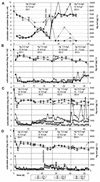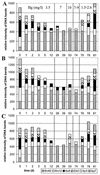Species diversity improves the efficiency of mercury-reducing biofilms under changing environmental conditions
- PMID: 12039739
- PMCID: PMC123942
- DOI: 10.1128/AEM.68.6.2829-2837.2002
Species diversity improves the efficiency of mercury-reducing biofilms under changing environmental conditions
Abstract
Six mercury-resistant environmental proteobacterial isolates and one genetically modified mercury-resistant Pseudomonas putida strain were analyzed for physiological traits of adaptive relevance in an environment of packed-bed bioreactors designed for the decontamination of mercury-polluted chlor-alkali wastewater. The strains displayed characteristic differences in each trait (i.e., biofilm formation capability, growth rate in mercury contaminated wastewaters, and mercury reduction efficiency). Subsequently, they were immobilized either as a monoculture or as a mixed culture on porous carrier material in packed-bed bioreactors through which different batches of filter-sterilized industrial chlor-alkali wastewater were pumped. In monospecies bioreactors, the mercury retention efficiency was sensitive to rapidly increasing mercury concentrations in the wastewater. Mixed culture biofilms displayed a high mercury retention efficiency that was not affected by rapid increases in mercury or continuously high mercury concentrations. The dynamic in the community composition of the mixed culture bioreactors was determined by ribosomal intergenic spacer polymorphism analysis. Mercury-mediated selective pressure decreased the number of prevalent strains. Microbial diversity was completely restored after easing of the selective pressure. Microbial diversity provides a reservoir of strains with complementary ecological niches that results in a superior bioreactor performance under changing environmental conditions.
Figures






Similar articles
-
Spatially oscillating activity and microbial succession of mercury-reducing biofilms in a technical-scale bioremediation system.Appl Environ Microbiol. 2002 Apr;68(4):1938-46. doi: 10.1128/AEM.68.4.1938-1946.2002. Appl Environ Microbiol. 2002. PMID: 11916716 Free PMC article.
-
Structure and species composition of mercury-reducing biofilms.Appl Environ Microbiol. 2000 Oct;66(10):4559-63. doi: 10.1128/AEM.66.10.4559-4563.2000. Appl Environ Microbiol. 2000. PMID: 11010917 Free PMC article.
-
Upflow anaerobic sludge blanket reactor--a review.Indian J Environ Health. 2001 Apr;43(2):1-82. Indian J Environ Health. 2001. PMID: 12397675 Review.
-
Removal of mercury from chloralkali electrolysis wastewater by a mercury-resistant Pseudomonas putida strain.Appl Environ Microbiol. 1999 Dec;65(12):5279-84. doi: 10.1128/AEM.65.12.5279-5284.1999. Appl Environ Microbiol. 1999. PMID: 10583977 Free PMC article.
-
Pilot plant for bioremediation of mercury-containing industrial wastewater.Appl Microbiol Biotechnol. 2003 Aug;62(2-3):124-33. doi: 10.1007/s00253-003-1322-7. Epub 2003 May 7. Appl Microbiol Biotechnol. 2003. PMID: 12734694 Review.
Cited by
-
Decolorization, degradation and detoxification of carcinogenic sulfonated azo dye methyl orange by newly developed biofilm consortia.Saudi J Biol Sci. 2021 Jan;28(1):793-804. doi: 10.1016/j.sjbs.2020.11.012. Epub 2020 Nov 11. Saudi J Biol Sci. 2021. PMID: 33424369 Free PMC article.
-
Metal-Adapted Bacteria Isolated From Wastewaters Produce Biofilms by Expressing Proteinaceous Curli Fimbriae and Cellulose Nanofibers.Front Microbiol. 2018 Jun 25;9:1334. doi: 10.3389/fmicb.2018.01334. eCollection 2018. Front Microbiol. 2018. PMID: 29988579 Free PMC article.
-
Synthetic Ecology of Microbes: Mathematical Models and Applications.J Mol Biol. 2016 Feb 27;428(5 Pt B):837-61. doi: 10.1016/j.jmb.2015.10.019. Epub 2015 Nov 11. J Mol Biol. 2016. PMID: 26522937 Free PMC article. Review.
-
Characterization of Bacterial and Fungal Assemblages From Historically Contaminated Metalliferous Soils Using Metagenomics Coupled With Diffusion Chambers and Microbial Traps.Front Microbiol. 2020 Jun 10;11:1024. doi: 10.3389/fmicb.2020.01024. eCollection 2020. Front Microbiol. 2020. PMID: 32655505 Free PMC article.
-
Unraveling interactions in microbial communities - from co-cultures to microbiomes.J Microbiol. 2015 May;53(5):295-305. doi: 10.1007/s12275-015-5060-1. Epub 2015 May 3. J Microbiol. 2015. PMID: 25935300 Review.
References
-
- Akagi, H., Y. Fujita, and E. Takabatake. 1977. Methylmercury: photochemical transformation of mercuric sulfide into methylmercury in aqueous solution. Photochem. Photobiol. 26:363-370.
-
- Brunke, M., W.-D. Deckwer, A. Frischmuth, J. M. Horn, H. Lünsdorf, M. Rhode, M. Rohricht, K. N. Timmis, and P. Weppen. 1993. Microbial retention of mercury from waste streams in a laboratory column containing merA gene bacteria. FEMS Microbiol. Rev. 11:145-152. - PubMed
-
- Chang, J. S., and J. Hong. 1995. Estimation of kinetics of mercury detoxification from low-inoculum batch cultures of Pseudomonas aeruginosa PU21 (Rip64). J. Biotechnol. 42:85-90. - PubMed
Publication types
MeSH terms
Substances
LinkOut - more resources
Full Text Sources
Other Literature Sources
Medical

